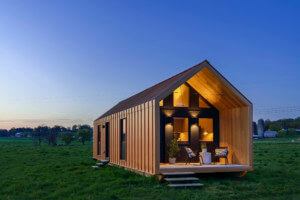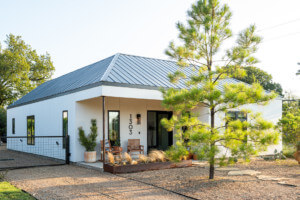In an effort to reduce the cost of housing even further, this prefabricated home proposal ditches the cost of a traditional lot entirely. The houseby UK-based Carl Turner Architects doesn’t need one—it floats.
Essentially a rubber-coated timber box nestled on a 65-foot-by-22-foot flood-proofing concrete tray, the home is outfitted with amenities for total self-sustenance just like a houseboat on open waters. Affixed to the interior is a pair of semi-translucent solar panels measuring 904 square feet, while a rooftop rainwater-harvesting tank—next to the crow’s nest on the rooftop balcony-cum-garden, of course—satisfies all non-drinkable water needs. Inside, meanwhile, the timber walls are bolstered with thick rubber insulation, while the triple-glazed windows keep inhabitants toasty.
Space-wise, there is nothing makeshift about this home. The living quarters, contained within a 45-foot-by-16-foot cross-laminated timber frame, consist of two bedrooms, a study, a bathroom, living room, and kitchen. While the tray beneath the house is buoyant (though non-movable), the house is designed to be amphibian: when constructed on land, the base disappears; when assembled on a floodplain, it can be buttressed by stilts or a non-floating, flood-resistant thick concrete base.
Like the prefab, the component parts of Floating House can be conveyed to the site by lorry or barge and simply lifted into position.
Designed to confront a recent uptick in flood incidents in London, Carl Turner Architects debuted Floating House via the open-source architecture project, PaperHouse. The firm has promised to upload the blueprints to the site, enabling anyone to download them and build their own buoyant home.










